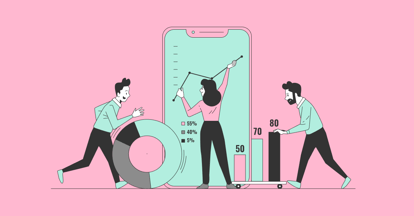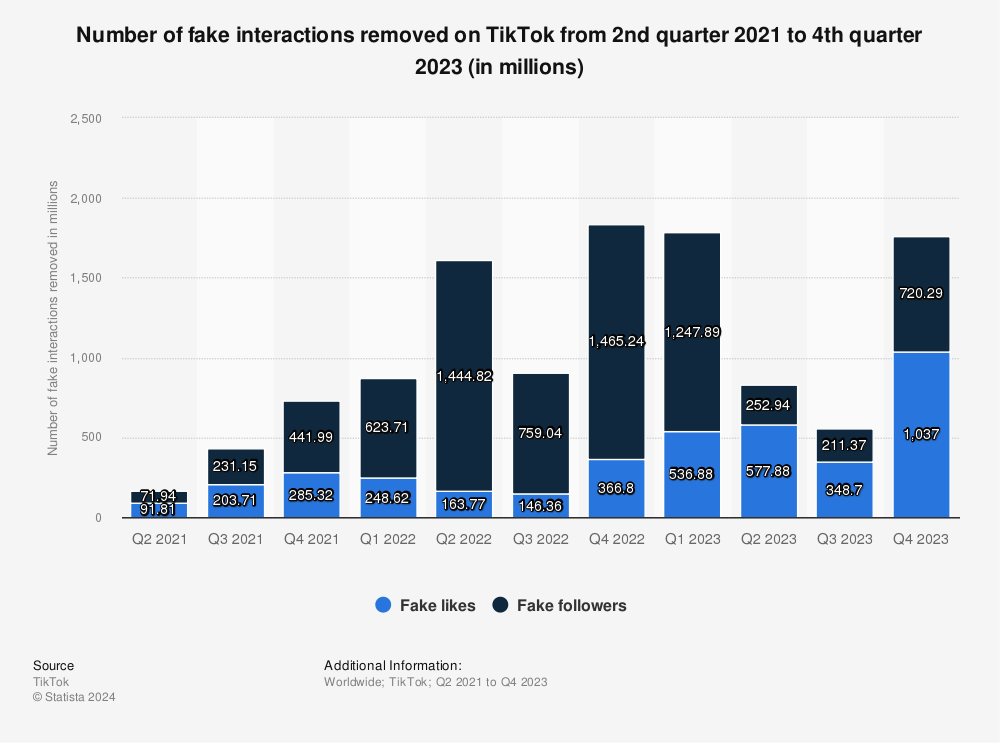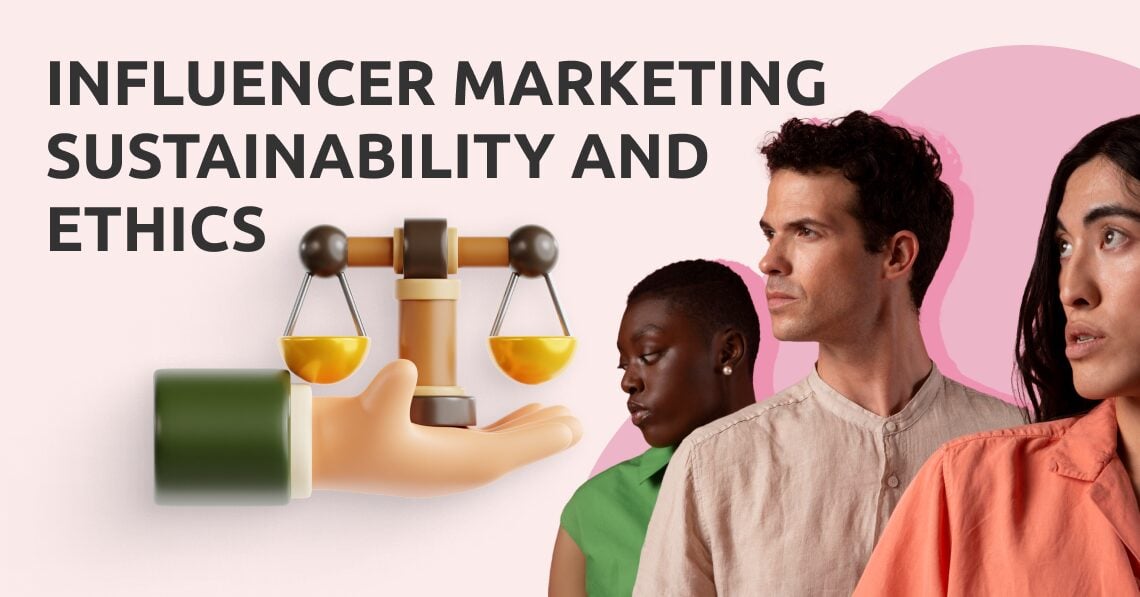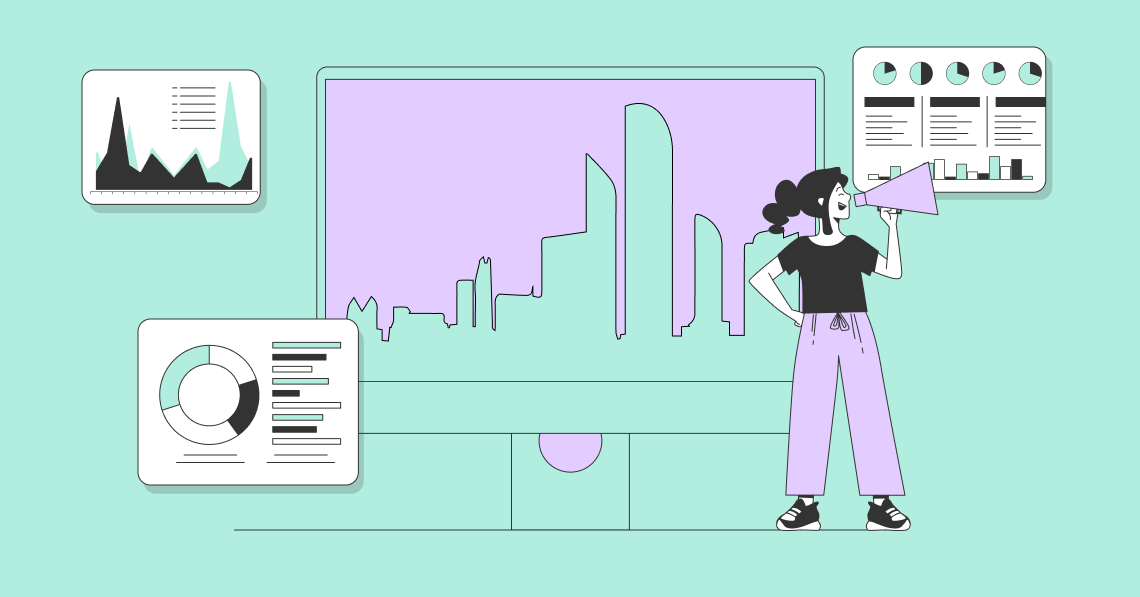Wondering what the influencer marketing landscape looks like right now? Are brands spending more or less on influencers? What types of influencers are they working with? There are plenty of influencer marketing statistics to keep up with to stay on top of the latest updates in the industry.
In this post, we narrow down some of the key influencer marketing statistics that should inform your strategy for 2024. From how much brands are spending on influencers to which payment methods they’re using—let’s check out these vital influencer marketing stats.
General Influencer Marketing Statistics
1. Marketers Prefer Working with Smaller Influencers
With smaller influencers often boasting higher engagement rates and lower rates, there’s a good reason brands prefer to work with them. The HubSpot 2024 Social Media Marketing Report found that 64% of marketers have worked with micro-influencers. And 47% of marketers experienced the most success with them.
However, micro-influencers aren’t the only small influencers that brands want to work with. Our own State of Influencer Marketing Benchmark Report 2024 noted a marked shift in partnerships with nano-influencers. There was a slight increase in brands that choose to work with nano-influencers, with 44% now preferring these smaller influencers. Meanwhile, the number of brands choosing to work with micro-influencers dropped from 30% to 25.7%.

Our State of Marketing Report 2024 further reinforces this notion, with 43% of brands shifting budgets towards smaller influencers.
2. Most Brands Are Spending Less than $50,000 on Influencer Marketing
The growing partnerships with smaller influencers may contribute to the increase in the number of brands spending less than $50,000 on influencer marketing. While 65% of brands were able to keep their spending within this threshold in 2023, the number increased to 68.3% in 2024.
This is largely owing to more brands keeping their influencer marketing spend below $10,000. In 2023, about 43% of brands spent less than $10,000 on influencer marketing. The number increased to 47.4% in 2024, while the number of brands spending between $10,000 and $50,000 dropped from 22% to 20.9%.
These patterns could be associated with the increased partnerships with nano-influencers, which has helped seasoned marketers reduce their influencer marketing spend. At the same time, these increased numbers could also include newcomers in the space experimenting with smaller budgets as they dabble with influencer marketing.

3. Keeping Up with Social Media Trends is the Biggest Influencer Marketing Challenge
For influencer marketing to be effective, it needs to resonate with the audience. This often requires being relevant to the latest trends and conversations taking place on social media. However, these trends evolve so rapidly that it’s hard for brands to keep up.
As such, the biggest challenge that many brands face with influencer marketing is keeping up with social media trends. According to Statista, 28% of social media marketers consider this the biggest challenge. Meanwhile, 26% experienced challenges related to cost.
Interestingly, brands that run campaigns in-house experience a unique set of challenges. Based on our State of Influencer Marketing report, 29.8% of respondents found it most challenging to find influencers to participate in their campaigns. Payment processing (17.1%), contract and deadline management (13.9%), and campaign measurement (13.6%) were another common challenge among respondents.
These numbers indicate a need to invest in robust influencer marketing platforms that will simplify most of these processes for you. Look for a platform that will come with all the essential features you need to manage your campaign in-house.
4. Fashion and Beauty Remains the Most Popular Vertical for Influencer Marketing
If you’re wondering which industries are making use of influencer marketing, the top vertical is fashion and beauty with 21.6% of brands in our study being from this industry. Gaming is another popular sector with 11.9% of respondents in this vertical, while sports, travel, and lifestyle followed closely at 8.6% each.
Other verticals making use of influencer marketing are family, parenting, and home at 7.6%. The health and fitness sector also has a 7.6% share.
Influencer Marketing Growth Statistics
5. Influencer Marketing is Growing into a $24 Billion Industry
As the number of brands using influencer marketing increases, it’s no surprise that the industry is experiencing significant growth. In 2023, the industry was valued at an impressive $21.1 billion, growing by 29% from $16.4 billion in 2022.
This year, our predictions show that the industry will be worth a whopping $24 billion by the end of 2024. In spite of the current economic conditions, the industry is seeing a strong growth momentum that’s not slowing down anytime soon.

6. Influencer Advertising Spend is Expected to Hit $35.09 Billion in 2024
The forecasted growth aligns with Statista’s prediction that ad spend in the influencer marketing space will reach $35.09 billion by 2024. This amounts to a 13.9% increase, which indicates that brands are continuing to spend more money on influencer advertising. On average, brands spend $6.16 per internet user on influencer advertising in 2024.
7. Marketers Are Increasing Their Influencer Marketing Spend
As you can expect from the above numbers, brands are ramping up their influencer marketing spend. Among respondents who had an influencer marketing budget, 59.4% plan on increasing their budget in 2024. This is a clear indicator that marketers are putting more investments into influencers after realizing the value they provide.
That said, a small fraction (about 9.3%) of respondents plan on decreasing their influencer marketing spend. This is slightly higher than in 2023, when only 7% intended to decrease their budgets on influencer marketing. The number could be more of a reflection of the current economic landscape rather than of the impact of influencer marketing itself.

8. More Brands Intend to Have Dedicated Influencer Marketing Budgets
As influencer marketing sees increased adoption, there’s also a positive pattern of brands taking a more organized approach to their campaigns. In fact, there’s a growing number of brands choosing to dedicate a budget for influencer marketing.
Back in 2017, when influencer marketing was starting to become increasingly popular, only 37% of respondents were planning to dedicate a budget for it. Now, that number has increased to an impressive 85.8%. This is a clear indicator that influencer marketing is maturing as marketers become more familiar with the landscape, allowing them to take a more structured approach.
Influencer Marketing ROI Statistics
9. Most Marketers Find Influencer Marketing Effective
If you’re still concerned about ROI, influencer marketing continues to be highly impactful for brands who’ve used it. According to our State of Influencer Marketing report, 84.8% of brands found influencer marketing to be effective. This is a slight increase from 2023 when 83% considered it to be an effective form of marketing.
10. Influencer Content Outperforms Branded Content
The value of influencers can be directly attributed to their content performance. According to a Linqia study, 36% of respondents say influencer content outperforms brand-created content. The improved performance may be in the form of metrics such as better reach and impressions as well as higher engagements and conversions.
With their creativity and authentic voice, influencers have the power to create engaging content that resonates with their audience. This often results in higher engagements and conversions, while their large following size typically guarantees increased reach.
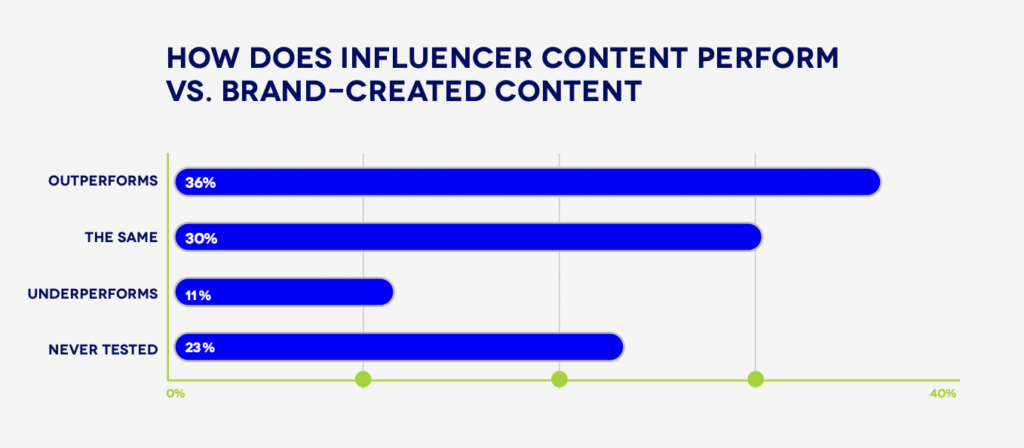
11. Most Brands Get Higher Quality Customers from Influencer Marketing
Influencer marketing also has an impact on the quality of customers, which eventually contributes to your bottom line. In our State of Influencer Marketing report, 83.8% of marketers reported gaining a better quality of customers from influencer marketing compared to other types of marketing.
This is largely owing to influencers’ ability to reach a niche audience that’s likely to be interested in what you have to sell, provided you’re working with the right customers. Moreover, influencers can attract high-intent customers who are most likely to convert since they often share informative content that guides buying decisions.
12. 30% of Brands Are Still Not Measuring Influencer Marketing ROI
Interestingly, although an increasing number of brands find influencer marketing to be effective, many of them don’t have definite proof. Based on our survey, 70% of brands are measuring the ROI of their influencer marketing campaigns. This leaves us with 30% of brands not yet measuring the results of their campaigns.
However, we might see these numbers decreasing over time as brands adopt dedicated influencer marketing platforms to help them measure ROI. Additionally, the need to showcase business value may push many marketers to start measuring the impact of their influencer campaigns.
Influencer Marketing Audience Statistics
13. 31% of Social Media Users Discover New Products through Influencers
If you’re still wondering why brands are spending so much on influencers, it’s because influencers drive product discovery. They’re a valuable resource for brands that want to drive brand awareness, attract new audiences, and promote their products. According to the HubSpot survey, 31% of social media users prefer to find out about new products through an influencer they follow as opposed to any other format or channel.
The numbers are particularly high among Gen Z consumers with 43% preferring influencers as a product discovery channel. So influencer marketing is a viable solution, particularly for brands that want to target a Gen Z audience.
14. Gen Z is Most Likely to Be Influenced by Influencer Recommendations
On the same note, the impact of influencers doesn’t just end at product discovery. In fact, influencers even influence people’s purchase decisions. Among social media users aged 18-54, 21% have made a purchase as a result of an influencer’s recommendation.
Among Gen Z social media users, the number shoots up to 32%. This shows that Gen Z consumers are much more likely than other generations to be influenced by influencer recommendations.
15. 61% of Consumers Find Relatable Influencers Most Appealing
Relatability is becoming an important factor influencing people’s content consumption. Similarly, as trust in influencers starts to decline, relatable influencers are gaining ground.
According to a study by Matter Communications, 61% of respondents found relatable personalities to be the most appealing. This indicates that consumers are favoring influencers who spark a sense of familiarity as they can relate to their experiences. Expert personalities were the second most preferred with 43% saying that they found these types of influencers appealing.
On the other hand, only 11% had a preference for celebrity personalities. There’s been a significant drop from the previous survey period of 2020 when 17-22% showed a preference for celebrity personalities. This is likely because these types of influencers often portray experiences that regular people can’t relate to.
16. Consumers Mainly Look to Influencers as an Educational Resource
Part of the reason why expert personalities are still one of the most preferred types of influencers is because consumers look to them as an educational resource. The same study by Matters Communications found that the most preferred types of influencer content are educational.
Forty-two percent of respondents expressed their preference for how-to content and tutorials. Stories with digestible bits of information are also popular among consumers, with 35% preferring this type of content.
Influencer Marketing Trends Stats
17. Influencer Fraud is Picking Back Up
In spite of a declining trend in influencer fraud between 2021 and 2022, the numbers are picking back up. Based on our survey, the number of brands experiencing influencer fraud has increased to 59.8% this year. This is a slight increase from 2023 when 55% of respondents experienced it.
So it’s no surprise that brands are rightfully concerned about it. About 71.7% of brands in our survey still have worries about experiencing influencer fraud.
18. AI and ML Usage in Influencer Campaigns is Set to Increase
Fortunately, there are now tools to help brands detect fraudulent influencers more easily, powered by AI and machine learning algorithms. This is one of the reasons why there’s a growing usage of AI and machine learning in influencer marketing. According to our survey, 63% of respondents were planning to use it in their campaigns.
Most brands plan on using AI and machine learning to help with influencer identification. Content curation and distribution was another common use case. Interestingly, only 5.7% intend to use AI to identify fraudulent influencers and engagement.
Considering the rise of brands that have concerns about influencer fraud, this low percentage comes as a shock. So there’s a possibility that many marketers aren’t yet familiar with the potential that AI has in curbing it.

19. Most Brands Work with 10+ Influencers
Even though brands are preferring to work with smaller influencers, they’re still carrying out influencer marketing on a larger scale. This shows in the number of influencers they work with. The IMH report found that about 62.4% of brands work with at least 10 influencers for their campaigns. By roping in more influencers, brands can maximize their reach and campaign impact.
According to the report, 19% of brands work with 10-50 influencers while 15.2% activate around 50-100 influencers for their campaigns. Some even go so far as to work with 1,000+ influencers.
20. Monetary Compensation is the Most Popular Influencer Payment Method
When influencer marketing really started gaining traction, many brands rewarded influencers with free gifts and experiences. This trend has gradually shifted over the years, with many influencers preferring to get paid in exchange for the content they create.
Our State of Influencer Marketing report even noted that the most common way to pay influencers today is through monetary compensation. That’s not to say that free products aren’t still popular—while 40.8% of respondents paid influencers money, 30.8% used free products. About 18.9% paid influencers by giving them discounts on their products.
If you’re wondering how brands are paying money to influencers, it seems like there’s been a shift from the previously popular flat rate system. Now the most popular payment system is a percentage of sales, with 49.6% of respondents using this method. This indicates that although brands are open to monetary compensation, they want to make sure that influencers are generating value to earn that compensation.

Platform-Specific Influencer Marketing Stats
21. TikTok Has Surpassed Instagram as the Most Popular Influencer Marketing Channel
For years, Instagram held the top spot as the most used social media platform for influencer marketing. Our latest State of Influencer Marketing report shows that TikTok has surpassed the platform. Now 68.8% of influencer marketing brands use TikTok, making it the most popular influencer marketing channel. This is a massive improvement, especially considering how it was merely lumped in with other channels back in 2021.

22. Influencers Get the Highest Engagement on TikTok
TikTok’s growing popularity among influencer marketers is likely because of its highly engaging nature. In fact, influencers see the highest engagement on the platform compared to other social media channels. Even the largest accounts with over 1 million followers see an average engagement rate of 10.53%.
Meanwhile, smaller accounts with 1,000 to 5,000 followers average 15.04% engagement. That’s enough reason to work with nano-influencers and smaller creators on TikTok.
23. A Majority of TikTok Creators are Nano-Influencers
And if you’re looking for nano-influencers to work with on TikTok, there’s an abundance of options. Influencers with 1,000 to 10,000 followers make up 66.96% of influencer accounts on TikTok. Micro-influencers are the second largest group, making up 23.06% of the TikTok influencer population.
24. TikTok is the Most Popular Platform for Beauty Influencers
For those in the beauty industry, this spells good news because TikTok is highly popular among influencers in this space. According to Statista, there are over 1.5 million beauty influencers on TikTok in the United States. Meanwhile, in the United Kingdom, Instagram and YouTube had 323k beauty influencers each. While we don’t have global data, this gives us a clear picture of the platform’s popularity among beauty content creators.
25. Influencer Fraud on TikTok is Decreasing
Even greater news for brands that want to work with influencers on TikTok is that influencer fraud on the platform is declining. In the first quarter of 2024, TikTok removed 32.6 million fake followers. This is a sharp contrast from 2023 when TikTok removed more than 1 billion fake followers during the same period and over 720 million fake followers during the previous quarter.
Similarly, over 236 million fake likes were removed during Q1 of 2024. In the previous quarter, the number of fake likes removed amounted to over 1 billion.
These improvements suggest that TikTok’s crackdown on influencer fraud is yielding some positive results. As influencer fraud declines on the platform, brands can more confidently work with influencers who can generate real results.
26. Instagram Takes Second Place Among Influencer Marketing Channels
Instagram’s reign as the undefeated champion of influencer marketing channels is finally over. With TikTok taking over as first place, Instagram is now the second most popular channel among influencer marketing brands.
The number of brands using it for influencer marketing has dipped below 50%, with only 46.7% now using it. In spite of this decrease in usage, it’s still a considerable popular choice compared to other platforms.
27. Influencer Engagement on Instagram is Dropping
Part of the reason for the drop in Instagram’s popularity among influencer marketing brands is the steady decline in engagement. Influencer engagement on the platform fell to its lowest level in five years, with average engagement standing at 2.05%. Accounts with over a million followers now see only 0.95% engagement while in 2018, the number stood at 1.97%.
28. Instagram Yields the Highest ROI
In spite of the low engagement rate, Instagram still yields high return on investment (ROI) for influencer marketing. Thirty percent of marketers in a HubSpot survey say that they get the biggest ROI for influencer marketing through the platform. In addition, 32% say that it’s the easiest platform for working with influencers.
YouTube and Facebook tie in terms of influencer marketing ROI, with 20% of marketers saying that they get the biggest ROI from these platforms. Interestingly, TikTok currently seems to perform the poorest, with only 14% of marketers saying they get the biggest ROI from the platform. This is likely because the platform is still fairly new compared to the others and may take some time to yield the kind of returns that marketers expect.
29. Instagram Influencer Fraud is Declining
Influencer fraud is another major reason for brands turning away from Instagram. That said, Instagram influencer fraud is seeing a declining trend. While 2023 saw 49.23% of Instagram influencers affected by fraud, the number fell to 36.8% this year.
30. A Majority of Instagram Influencers are Nano-Influencers
Like TikTok, nano-influencers make up the majority of the influencer population on Instagram. Statista reports that 76.86% of influencer accounts have 1,000 to 10,000 followers. Micro-influencers are the second most popular group, but they account for just 18.23% of influencer accounts on the platform.
31. YouTube Has Surpassed Facebook as the Third Most Popular Influencer Marketing Channel
Although Facebook consistently held its own as one of the three most popular channels for influencer marketing, YouTube is finally taking over. With 33.1% of influencer marketing brands using YouTube, it’s now the third most popular channel to work with influencers. Meanwhile, 27.5% of influencer marketing brands use Facebook.
32. Larger YouTube Influencers See Higher Engagement
Interestingly, YouTube is likely the only platform where larger influencers get higher engagements. According to our State of Influencer Marketing report, YouTube accounts with 1,000 to 5,000 subscribers see an average engagement of 1.9%. Accounts with over a million followers see an engagement rate of 3.4%.
Accounts that see the highest engagement have 500,000 to 1 million followers, with a 3.47% engagement rate. If you plan on using YouTube in your influencer marketing campaign, you’ll want to take these numbers into consideration.

33. The Majority of YouTube Influencers are Small and Mid-Size Creators
We’re also seeing some deviation in the distribution of influencer accounts based on size. While nano-influencers make up a majority on other platforms, YouTube sees more small and mid-size creators.
Almost 307k YouTube influencers in the United States have 10,000 to 50,000 followers. Nano-influencers are the second most popular category with 70,000 of them having between 5,000 and 10,000 followers. Although we don’t have global data, these numbers can paint a picture of what the influencer landscape looks like on the platform.
34. Vlogs are the Most Popular YouTube Influencer Category
If you’re interested in working with YouTube influencers, you’ll want to look at the types of content they’re posting. According to Statista, vlogging is the most popular category, with 28.5% of influencers posting about people and blogs. Entertainment is another popular category with 14.54% of influencers posting about it. Video games are also highly popular, with 12.95% of influencers posting about it.
35. Steam is the Most Popular Brand Among YouTube Influencers
With gaming being one of the most popular categories, it’s no surprise that Steam takes the top spot as the most-mentioned brand on YouTube. Statista reports that the video distribution service had over 76,000 mentions. This was followed by AliExpress with over 53,000 mentions and Flipkart with over 49,000 mentions.
Liked These Insights? Find Out More Essential Stats for 2024
These influencer marketing stats should give you a better understanding of what the current landscape looks like and how you can shape your own strategy. You can use the data to understand which platforms to use, what types of influencers to work with, and how much you can budget for influencer marketing.
If you liked these insights, check out some of our other stats to inform your marketing for 2024:
- 40 Vital TikTok Stats to Inform Your Marketing Strategy
- 42 Useful and Updated Twitch Stats for Influencer Marketing Managers
- The Facebook Stats Every Marketer Should Know: A Complete List
- 100 Mind Blowing Instagram Stats You Need to Wrap Your Head Around
- Top Threads App Stats to Have Marketers Thinking in 2024
- Top 13 TikTok Shop Stats for 2024
Frequently Asked Questions
What trends are shaping the influencer marketing industry?
Technological innovations, changing consumer behaviors, and the need for transparency are impacting the way brands and influencers approach marketing campaigns.
Also, social media platforms are now becoming easier to use and more accessible, making it relatively easy for anyone to become influencers themselves.
How many followers do I need to have to become an influencer?
Ideally, you need between 1,000 and 10,000 followers to become an influencer, specifically a nano-influencer. If you’re just starting and building your follower base, make notes on important metrics, such as your engagement rates. Nano- and micro-influencers have higher engagement rates, which are more attractive to some brands than the number of followers, so make sure you drive engagement on your account regularly.
What are the most important metrics to track when measuring influencer marketing ROI?
The most important metrics to track when measuring influencer marketing ROI include:
- Engagement rate (likes, comments, shares, clicks)
- Conversion rate (leads, sales, sign-ups, downloads)
- Reach and impressions
- Cost per mille (CPM)
- Follower growth
By monitoring these key performance indicators, brands can gain a comprehensive understanding of the effectiveness and profitability of their influencer campaigns.
